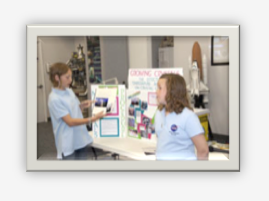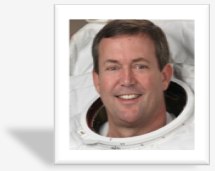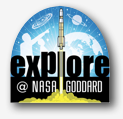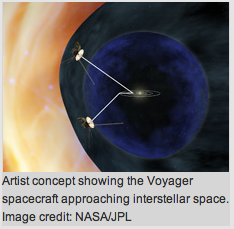 Inspiring the next generation of explorers, scientists, engineers and educators to “dream big” was the goal of this year’s NASA Explorer Schools National Student Symposium at Kennedy Space Center in Florida.
Inspiring the next generation of explorers, scientists, engineers and educators to “dream big” was the goal of this year’s NASA Explorer Schools National Student Symposium at Kennedy Space Center in Florida.
The symposium kicked off May 4 with a welcome dinner in the company of Bob Cabana, Kennedy’s director and a former space shuttle astronaut. About 60 fourth- through 12th-grade students and their teachers listened in awe as Cabana shared a vivid memory of seeing shuttle Endeavour awaiting liftoff on Launch Pad 39A with a remarkable rainbow overhead. Later that day in December 1998, Cabana and his crew would lift off on the 12-day STS-88 mission to begin construction of the International Space Station.
“Our very first day in orbit, the wake up music was Judy Garland, ‘Somewhere Over the Rainbow.’ It brought tears to my eyes,” Cabana said. “Somewhere over the rainbow dreams do come true because that was a dream mission from start to finish.” STS-88 took the first American module called Unity to the station and connected it to the Russian-built Zarya module, beginning the more than 10-year international collaboration and mechanical marvel in space.
The symposium participants were competitively selected after they completed an original investigation focused on existing NASA missions or research interests and presented it to the space agency via the Digital Learning Network. As their reward, they spent four days at the space center touring processing and launch facilities and the U.S. Astronaut Hall of Fame, as well as participating in educational activities and a career panel question-and-answer session. They also presented their investigations to fellow students and NASA employees.
“Thank you, NASA, for this great opportunity,” said EmmaLee Beason, a fifth-grader from Oceanair Elementary in Norfolk, Va.
Beason and her classmate, Iyana Stephenson, came up with their growing yeast in balloons experiment using different temperatures of water investigation after their teacher, Colleen Orman, traveled to Yellowstone National Park and taught them about geysers and organisms that thrive in extreme conditions. They found that the yeast organism preferred moderate temperatures, instead of extreme.
When asked what career field she would like to join when she gets a little older, Beason said an astrobiologist or a chef, or perhaps a chef for astronauts. She said working on this investigation taught her a lot about teamwork.
“Let’s say I become a chef and dinner service is in an hour and I’ve run out of a really important ingredient, I have to be able to trust my partner to run out and get that ingredient to finish the main dish,” Beason said. “And in astrobiology, I may need someone to help analyze data and materials.”
Luis Rabelo, a project manager for NASA’s Experimental Program to Stimulate Competitive Research, or EPSCoR, was on hand to listen to the students’ presentations and explained the multitude of career paths the space agency offers, including studying Earth’s climate, the sun, the solar system, or galaxies and black holes, as well as designing and launching rockets and capsules that will travel to low Earth orbit and beyond.
“Keep learning,” Rabelo said. “Continuous learning is so important because science is always changing.”
Fifth-graders Nell Curtin and Hazel Thurston from K.W. Barrett Elementary in Arlington, Va., and their classmates developed a sports game for space, called “Save the World,” using Sir Isaac Newton’s three laws of motion for their investigation. The project was awarded the “NASA Sports Challenge” and will be played aboard the International Space Station later this year, with a few modifications. The goal is for astronauts to gather objects and build devices to save the planet, which actually is just a large, soft ball, from incoming meteorites.
Thurston ended their presentation with a small piece of advice for the space participants: “Play safe.”
Curtin said if she could ask the astronauts questions after they played, they would be, “Who won?” and “What was the most challenging part?”
Alicia Baturoni, a lead education specialist at NASA’s Glenn Research Center in Cleveland, asked the adults in attendance to think back to where they were when they were in elementary school.
“You’ve got a great head start,” Baturoni told the students. “I hope you are all really proud of yourselves.”
A day later, career panelist and chemical engineer Annie Caraccio echoed those sentiments.
“When I was in fourth-grade, I think I was only interested in Girl Scouts and playing soccer outside,” Caraccio said. “So congratulations . . . I look forward to seeing you accomplish great things and working with you in the future.”
Baturoni moderated the career panel, which boasted a wide variety of Kennedy employees, from a wildlife ecologist and human resource specialist to a chemist, engineer and contracting officer.
Afterward, the students participated in hands-on educational and skill-building activities. Elementary students built miniature robots using things like toothbrush bristles, wires and a small battery. The high schoolers built speakers using things like copper wire, a foam plate and a magnet.
As they worked on their speakers, Fernando Zamora-Jimenez and Jakob Ingra, eighth-graders from High Point, N.C., talked about the investigation that brought them to Kennedy. They took cinnamon basil seeds that were flown in space and compared their growth to seeds that remained on Earth. They found that the space-flown seeds grew faster in the beginning, but also died faster. Their conclusion: The space-flown seeds weren’t accustomed to Earth’s climate.
“From this experience, I’ve learned that if you try your hardest, there really are rewards,” said Zamora-Jimenez, who is looking forward to joining the veterinarian or medical field and obtaining a private or commercial pilot’s license.
In the past, the NASA Explorer School Symposium only was open to fifth- through ninth-grade students. Priscilla Moore, an education specialist at Kennedy, explained the reason for opening it up to older students was to deliver NASA educational content to a much broader audience.
“The NASA Explorer Schools mission is to be the agency’s classroom-based gateway to middle and high school students,” said Moore, “inspiring them to participate in NASA missions and develop their aptitudes in science, technology, engineering and math.”
Rebecca Regan
NASA’s John F. Kennedy Space Center
 NASA Explorer Schools would like to extend an invitation to K-12 students across the United States to participate in a webchat with astronaut and veteran spacewalker Mike Foreman. The event will take place from 1 to 2 p.m. EST on Nov. 22, 2010. Foreman will answer questions about his spacewalking experiences, living and working in the microgravity environment of space, and his unique career path from high school through astronaut training.
NASA Explorer Schools would like to extend an invitation to K-12 students across the United States to participate in a webchat with astronaut and veteran spacewalker Mike Foreman. The event will take place from 1 to 2 p.m. EST on Nov. 22, 2010. Foreman will answer questions about his spacewalking experiences, living and working in the microgravity environment of space, and his unique career path from high school through astronaut training.
 Inspiring the next generation of explorers, scientists, engineers and educators to “dream big” was the goal of this year’s NASA Explorer Schools National Student Symposium at Kennedy Space Center in Florida.
Inspiring the next generation of explorers, scientists, engineers and educators to “dream big” was the goal of this year’s NASA Explorer Schools National Student Symposium at Kennedy Space Center in Florida. 

 NASA Explorer Schools invites K-12 students across the United States to chat with NASA civil engineer Sam Ortega, Program Manager of Centennial Challenge. Ortega will answer questions about building and testing solid fuel rocket motors and being a civil engineer at NASA during a live video webchat tomorrow, Tuesday April 19, 2011 at 2 p.m. EDT.
NASA Explorer Schools invites K-12 students across the United States to chat with NASA civil engineer Sam Ortega, Program Manager of Centennial Challenge. Ortega will answer questions about building and testing solid fuel rocket motors and being a civil engineer at NASA during a live video webchat tomorrow, Tuesday April 19, 2011 at 2 p.m. EDT. NASA’s Voyager spacecraft are hurtling towards the edge of our solar system, more than 10 billion miles away from our sun. Interstellar space – the medium between stars – is a region no human-made craft has ever been. On Apr. 28, 2011, a live NASA TV program will feature mission scientists discussing the distant areas Voyager 1 and 2 are exploring, 10 billion miles away from our sun.
NASA’s Voyager spacecraft are hurtling towards the edge of our solar system, more than 10 billion miles away from our sun. Interstellar space – the medium between stars – is a region no human-made craft has ever been. On Apr. 28, 2011, a live NASA TV program will feature mission scientists discussing the distant areas Voyager 1 and 2 are exploring, 10 billion miles away from our sun.  In this episode of NASA Now, you will learn what it’s like to study the atmospheres of other planets. We are approaching the first day of spring in the Northern Hemisphere and the first day of autumn in the Southern Hemisphere. Dr. Kelly Fast, astrophysicist at NASA’s Goddard Space Flight Center in Greenbelt, Md., discusses the reason for the seasons. Fast explains what an equinox is and whether or not other planets in our solar system have seasons.
In this episode of NASA Now, you will learn what it’s like to study the atmospheres of other planets. We are approaching the first day of spring in the Northern Hemisphere and the first day of autumn in the Southern Hemisphere. Dr. Kelly Fast, astrophysicist at NASA’s Goddard Space Flight Center in Greenbelt, Md., discusses the reason for the seasons. Fast explains what an equinox is and whether or not other planets in our solar system have seasons. NASA Explorer Schools invites students in grades K-12 from across the U.S. and Department of Defense schools to participate in a live video chat with NASA engineer aquanaut Tara Ruttley. The event will take place on March 15, 2011, at 1 p.m. EDT. Students and teachers can submit questions to Dr. Ruttley during this hour-long chat. Ruttley will answer questions about participating in the NEEMO 6 project and her career as an engineer aquanaut and Associate International Space Station Program Scientist.
NASA Explorer Schools invites students in grades K-12 from across the U.S. and Department of Defense schools to participate in a live video chat with NASA engineer aquanaut Tara Ruttley. The event will take place on March 15, 2011, at 1 p.m. EDT. Students and teachers can submit questions to Dr. Ruttley during this hour-long chat. Ruttley will answer questions about participating in the NEEMO 6 project and her career as an engineer aquanaut and Associate International Space Station Program Scientist. Applications for membership to the 2011 – 2012 INSPIRE Online Learning Community, or OLC, are now being accepted. The deadline for applying is
Applications for membership to the 2011 – 2012 INSPIRE Online Learning Community, or OLC, are now being accepted. The deadline for applying is